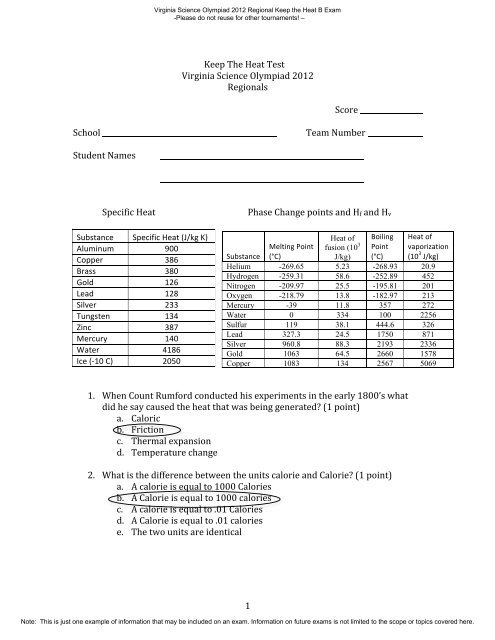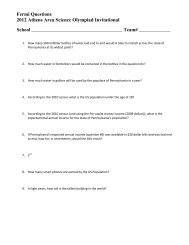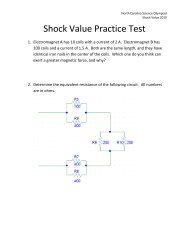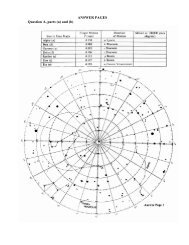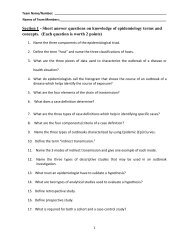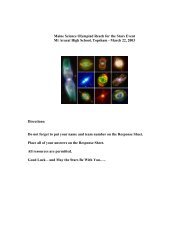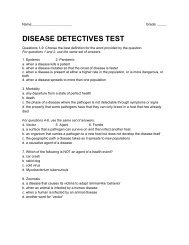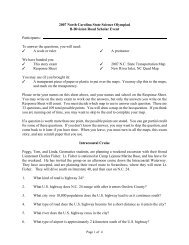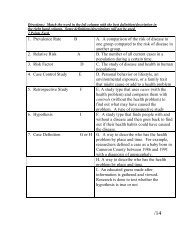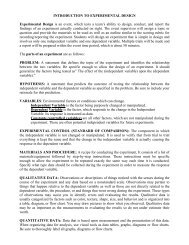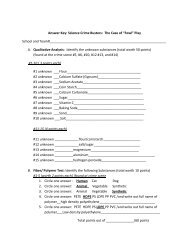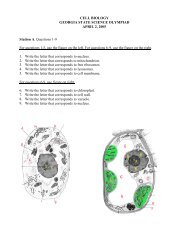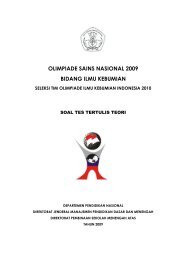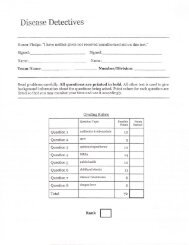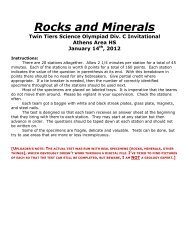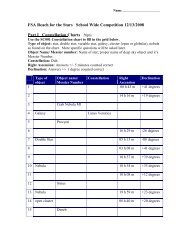1 Keep The Heat Test Virginia Science Olympiad 2012 Regionals Scor
1 Keep The Heat Test Virginia Science Olympiad 2012 Regionals Scor
1 Keep The Heat Test Virginia Science Olympiad 2012 Regionals Scor
Create successful ePaper yourself
Turn your PDF publications into a flip-book with our unique Google optimized e-Paper software.
<strong>Keep</strong> <strong>The</strong> <strong>Heat</strong> <strong>Test</strong><br />
<strong>Virginia</strong> <strong>Science</strong> <strong>Olympiad</strong> <strong>2012</strong><br />
<strong>Regionals</strong><br />
1<br />
<strong>Scor</strong>e<br />
School Team Number<br />
Student Names<br />
Specific <strong>Heat</strong> Phase Change points and Hf and Hv<br />
Substance Specific <strong>Heat</strong> (J/kg K)<br />
Aluminum 900<br />
Copper 386<br />
Brass 380<br />
Gold 126<br />
Lead 128<br />
Silver 233<br />
Tungsten 134<br />
Zinc 387<br />
Mercury 140<br />
Water 4186<br />
Ice (-‐10 C) 2050<br />
<strong>Virginia</strong> <strong>Science</strong> <strong>Olympiad</strong> <strong>2012</strong> Regional <strong>Keep</strong> the <strong>Heat</strong> B Exam<br />
-Please do not reuse for other tournaments! –<br />
<strong>Heat</strong> of<br />
fusion (10 3<br />
Boiling<br />
Point<br />
(°C)<br />
1. When Count Rumford conducted his experiments in the early 1800’s what<br />
did he say caused the heat that was being generated? (1 point)<br />
a. Caloric<br />
b. Friction<br />
c. <strong>The</strong>rmal expansion<br />
d. Temperature change<br />
2. What is the difference between the units calorie and Calorie? (1 point)<br />
a. A calorie is equal to 1000 Calories<br />
b. A Calorie is equal to 1000 calories<br />
c. A calorie is equal to .01 Calories<br />
d. A Calorie is equal to .01 calories<br />
e. <strong>The</strong> two units are identical<br />
<strong>Heat</strong> of<br />
vaporization<br />
(10 3 J/kg)<br />
Substance<br />
Melting Point<br />
(°C)<br />
J/kg)<br />
Helium -269.65 5.23 -268.93 20.9<br />
Hydrogen -259.31 58.6 -252.89 452<br />
Nitrogen -209.97 25.5 -195.81 201<br />
Oxygen -218.79 13.8 -182.97 213<br />
Mercury -39 11.8 357 272<br />
Water 0 334 100 2256<br />
Sulfur 119 38.1 444.6 326<br />
Lead 327.3 24.5 1750 871<br />
Silver 960.8 88.3 2193 2336<br />
Gold 1063 64.5 2660 1578<br />
Copper 1083 134 2567 5069<br />
Note: This is just one example of information that may be included on an exam. Information on future exams is not limited to the scope or topics covered here.
3. Which statement is more correct? (3 points)<br />
a. <strong>Heat</strong> rises.<br />
b. Warm air rises.<br />
c. Neither is correct.<br />
Explain your answer.<br />
Warm air rises in cooler air, heat does not rise, <strong>Heat</strong> is simply what we call the<br />
transfer of thermal energy.<br />
<strong>The</strong>y could also answer “c. Neither is correct.” if they say that for b. to be<br />
correct it had to say “warmer” air rises rather than simply “warm” air.<br />
4. Convert the following temperatures (2 points each)<br />
Show your work.<br />
a. 47 °C to °F<br />
(47°C +40) X 1.8 – 40 = 117°F<br />
<strong>The</strong>y could also use:<br />
(9/5) X°C + 32 for °C to °F and<br />
X°F(5/9) – 32 for °F to °C<br />
b. 376°F to K<br />
((376°F + 40)/1.8)-‐40 = 191°C<br />
271.1°C+ 273.15 = 464.15K<br />
c. -‐135°F to °C<br />
((135°F + 40)/1.8)-‐40 = 57°C<br />
d. 189 K to °C<br />
189K – 273.15 = -‐84.15°C<br />
e. 14 °C to K<br />
<strong>Virginia</strong> <strong>Science</strong> <strong>Olympiad</strong> <strong>2012</strong> Regional <strong>Keep</strong> the <strong>Heat</strong> B Exam<br />
-Please do not reuse for other tournaments! –<br />
14 °C +273.15 = 287.15K<br />
2<br />
Note: This is just one example of information that may be included on an exam. Information on future exams is not limited to the scope or topics covered here.
<strong>Virginia</strong> <strong>Science</strong> <strong>Olympiad</strong> <strong>2012</strong> Regional <strong>Keep</strong> the <strong>Heat</strong> B Exam<br />
-Please do not reuse for other tournaments! –<br />
5. Draw and label examples of the three (3) ways that thermal energy is<br />
transferred between substances. (10 points)<br />
<strong>The</strong>y should draw and label pictures that clearly describe convection,<br />
conduction, and radiation. Important parts of the drawing should be labeled.<br />
6. Compare and contrast temperature and thermal energy. Be sure to include<br />
similarities and differences. (5 points)<br />
Answers will vary but should include the following points<br />
Temperature<br />
• Average<br />
kinetic<br />
energy of<br />
the<br />
molecules<br />
• Measured in<br />
°C or Kelvin<br />
(K)<br />
Molecular<br />
kinetic<br />
energy<br />
3<br />
<strong>The</strong>rmal Energy<br />
Total internal<br />
energy of a<br />
substance<br />
including<br />
kinetic energy<br />
and potential<br />
energy<br />
Measured in<br />
Joules (or<br />
calories)<br />
Note: This is just one example of information that may be included on an exam. Information on future exams is not limited to the scope or topics covered here.
<strong>Virginia</strong> <strong>Science</strong> <strong>Olympiad</strong> <strong>2012</strong> Regional <strong>Keep</strong> the <strong>Heat</strong> B Exam<br />
-Please do not reuse for other tournaments! –<br />
7. An aluminum pan and a glass dish filled with water are taken out of a 80 °C<br />
oven and placed on the counter in a 23°C kitchen. <strong>The</strong> mass of both is 1.0 Kg.<br />
What do you predict their temperatures will be after 20 minutes and why? Be<br />
as specific as possible. (5 points)<br />
<strong>The</strong>ir answer should indicate that the aluminum pan will be closer to room<br />
temperature than the water.<br />
<strong>The</strong>ir explanation should include that because the specific heat of aluminum is<br />
so much less than water’s the pan will cool much more quickly under these<br />
conditions.<br />
It is expected they will say the pan would be close to 23°C while the water<br />
would still be above that temperature.<br />
8. Draw and describe how a liquid filled<br />
thermometer measures temperature. (5<br />
points)<br />
<strong>The</strong> liquid inside expands when its temperature<br />
increases causing the temperature on the<br />
thermometer to increase. When it cools, the<br />
opposite occurs.<br />
4<br />
Note: This is just one example of information that may be included on an exam. Information on future exams is not limited to the scope or topics covered here.
Temperature (°C)<br />
9. How much energy (in Joules) is needed to heat 750g of copper from 10°C to<br />
37°C? You MUST show all your work to get credit. (5 points)<br />
Q = mC ΔT<br />
750g * 1Kg/1000g = .75 Kg ΔT= 310K – 283K = 27K<br />
Q = .75Kg * (386J/KgK) * 27K<br />
Q = 7817 J or 7.817 KJ<br />
10. Using the information in the Latent <strong>Heat</strong>s of Fusion and Vaporization Table<br />
on the first page, sketch a graph showing what would happen to temperature<br />
over time as energy was added to sulfur at 50°C as it was changed into a gas.<br />
(5 points)<br />
446<br />
119<br />
50<br />
<strong>Virginia</strong> <strong>Science</strong> <strong>Olympiad</strong> <strong>2012</strong> Regional <strong>Keep</strong> the <strong>Heat</strong> B Exam<br />
-Please do not reuse for other tournaments! –<br />
<strong>The</strong> effect of energy on the temperature of sulfur<br />
Time (min)<br />
5<br />
Note: This is just one example of information that may be included on an exam. Information on future exams is not limited to the scope or topics covered here.
<strong>Keep</strong> <strong>The</strong> <strong>Heat</strong> <strong>Test</strong><br />
<strong>Virginia</strong> <strong>Science</strong> <strong>Olympiad</strong> <strong>2012</strong><br />
<strong>Regionals</strong><br />
1<br />
<strong>Scor</strong>e<br />
School Team Number<br />
Student Names<br />
Substance<br />
<strong>Virginia</strong> <strong>Science</strong> <strong>Olympiad</strong> <strong>2012</strong> Regional <strong>Keep</strong> the <strong>Heat</strong> B Exam<br />
-Please do not reuse for other tournaments! –<br />
Specific <strong>Heat</strong> Phase Change Points, Hf and Hv<br />
Specific <strong>Heat</strong><br />
(J/kg K) Substance<br />
Melting<br />
Point (°C)<br />
<strong>Heat</strong> of<br />
fusion<br />
(10 3 J/kg)<br />
Boiling<br />
Point<br />
(°C)<br />
-<br />
<strong>Heat</strong> of<br />
vaporization<br />
(10 3 J/kg)<br />
Aluminum 900 Helium -269.65 5.23 268.93 20.9<br />
-<br />
Copper 386 Hydrogen -259.31 58.6 252.89 452<br />
-<br />
Brass 380 Nitrogen -209.97 25.5 195.81 201<br />
-<br />
Gold 126 Oxygen -218.79 13.8 182.97 213<br />
Lead 128 Mercury -39 11.8 357 272<br />
Silver 233 Water 0 334 100 2256<br />
Tungsten 134 Sulfur 119 38.1 444.6 326<br />
Zinc 387 Lead 327.3 24.5 1750 871<br />
Mercury 140 Silver 960.8 88.3 2193 2336<br />
Water 4186 Gold 1063 64.5 2660 1578<br />
Ice (-‐10 C) 2050 Copper 1083 134 2567 5069<br />
1. When Count Rumford conducted his experiments in the early 1800’s what<br />
did he say caused the heat that was being generated? (1 point)<br />
a. Caloric<br />
b. Friction<br />
c. <strong>The</strong>rmal expansion<br />
d. Temperature change<br />
2. What is the difference between the units calorie and Calorie? (1 point)<br />
a. A calorie is equal to 1000 Calories<br />
b. A Calorie is equal to 1000 calories<br />
c. A calorie is equal to .01 Calories<br />
d. A Calorie is equal to .01 calories<br />
e. <strong>The</strong> two units are identical<br />
Note: This is just one example of information that may be included on an exam. Information on future exams is not limited to the scope or topics covered here.
3. Which statement is more correct? (3 points)<br />
a. <strong>Heat</strong> rises.<br />
b. Warm air rises.<br />
c. Neither is correct.<br />
Explain your answer.<br />
4. Convert the following temperatures (2 points each)<br />
Show your work.<br />
a. 47 °C to °F<br />
b. 376°F to K<br />
c. -135°F to °C<br />
d. 189 K to °C<br />
e. 14 °C to K<br />
<strong>Virginia</strong> <strong>Science</strong> <strong>Olympiad</strong> <strong>2012</strong> Regional <strong>Keep</strong> the <strong>Heat</strong> B Exam<br />
-Please do not reuse for other tournaments! –<br />
2<br />
Note: This is just one example of information that may be included on an exam. Information on future exams is not limited to the scope or topics covered here.
<strong>Virginia</strong> <strong>Science</strong> <strong>Olympiad</strong> <strong>2012</strong> Regional <strong>Keep</strong> the <strong>Heat</strong> B Exam<br />
-Please do not reuse for other tournaments! –<br />
5. Draw and label examples of the three (3) ways that thermal energy is<br />
transferred between substances. (10 points)<br />
6. Compare and contrast temperature and thermal energy. Be sure to include<br />
similarities and differences. (5 points)<br />
3<br />
Note: This is just one example of information that may be included on an exam. Information on future exams is not limited to the scope or topics covered here.
<strong>Virginia</strong> <strong>Science</strong> <strong>Olympiad</strong> <strong>2012</strong> Regional <strong>Keep</strong> the <strong>Heat</strong> B Exam<br />
-Please do not reuse for other tournaments! –<br />
7. An empty aluminum pan and a glass dish filled with water are taken out of a<br />
180 °C oven and placed on the counter in a 23°C kitchen. <strong>The</strong> mass of both is<br />
the same. What do you predict the temperatures of the empty aluminum pan<br />
and the glass dish with water will be after 20 minutes and why? Be as specific<br />
as possible. (5 points)<br />
8. Draw and describe how a liquid filled thermometer measures temperature.<br />
(5 points)<br />
4<br />
Note: This is just one example of information that may be included on an exam. Information on future exams is not limited to the scope or topics covered here.
<strong>Virginia</strong> <strong>Science</strong> <strong>Olympiad</strong> <strong>2012</strong> Regional <strong>Keep</strong> the <strong>Heat</strong> B Exam<br />
-Please do not reuse for other tournaments! –<br />
9. How much energy (in Joules) is needed to heat 750g of copper from 10°C to<br />
37°C? You MUST show all your work to get credit. (5 points)<br />
10. Using the information in the Phase Change Points, Hf and Hv Table on the first<br />
page, sketch a complete, properly labeled graph showing what would happen<br />
to temperature over time as energy was added to sulfur at 50°C as it was<br />
changed into a gas. (5 points)<br />
5<br />
Note: This is just one example of information that may be included on an exam. Information on future exams is not limited to the scope or topics covered here.
<strong>Keep</strong> <strong>The</strong> <strong>Heat</strong><br />
<strong>Scor</strong>e Sheet<br />
<strong>Virginia</strong> <strong>Science</strong> <strong>Olympiad</strong> <strong>2012</strong><br />
School Team Number<br />
Student Names (please PRINT clearly)<br />
Device Design Requirements (Must me all requirements to be in 1 st Tier)<br />
� Fits inside a 30.0cm x 30.0cm x 30.0cm cube<br />
� Hole in center of lid is ≥ 1.5cm<br />
� Distance from top of hole to top lip of beaker is ≤ 5.o cm<br />
� 2 – 250mL beakers<br />
Plot <strong>Scor</strong>e<br />
� Plot labeled with School and Students’ Names 2 pts<br />
� Plot titled appropriately and with x and y axes labeled 2 pts<br />
� Appropriate units listed and axis increments 2 pts<br />
� Number of Plots/graphs turned in X 1 pt (max:4 pts)<br />
Final <strong>Scor</strong>e Calculation<br />
i. <strong>Test</strong> <strong>Scor</strong>e (Max: 50)<br />
ii. Plot <strong>Scor</strong>e(Max: 10)<br />
iii. <strong>Heat</strong> Retention <strong>Scor</strong>e (HRS) *<br />
iv. Prediction <strong>Scor</strong>e (PS) **<br />
<strong>Virginia</strong> <strong>Science</strong> <strong>Olympiad</strong> <strong>2012</strong> Regional <strong>Keep</strong> the <strong>Heat</strong> B Exam<br />
-Please do not reuse for other tournaments! –<br />
Total <strong>Scor</strong>e<br />
Total Plot <strong>Scor</strong>e<br />
Final Ranking Tier 1 Tier 2<br />
* HRS = ((internal beaker water temp/external beaker water temp)-‐1)X 50<br />
**PS = (1 -‐ (abs(Final internal water temp-‐predicted internal water temp/final<br />
internal water temp)) X 25<br />
Note: This is just one example of information that may be included on an exam. Information on future exams is not limited to the scope or topics covered here.


